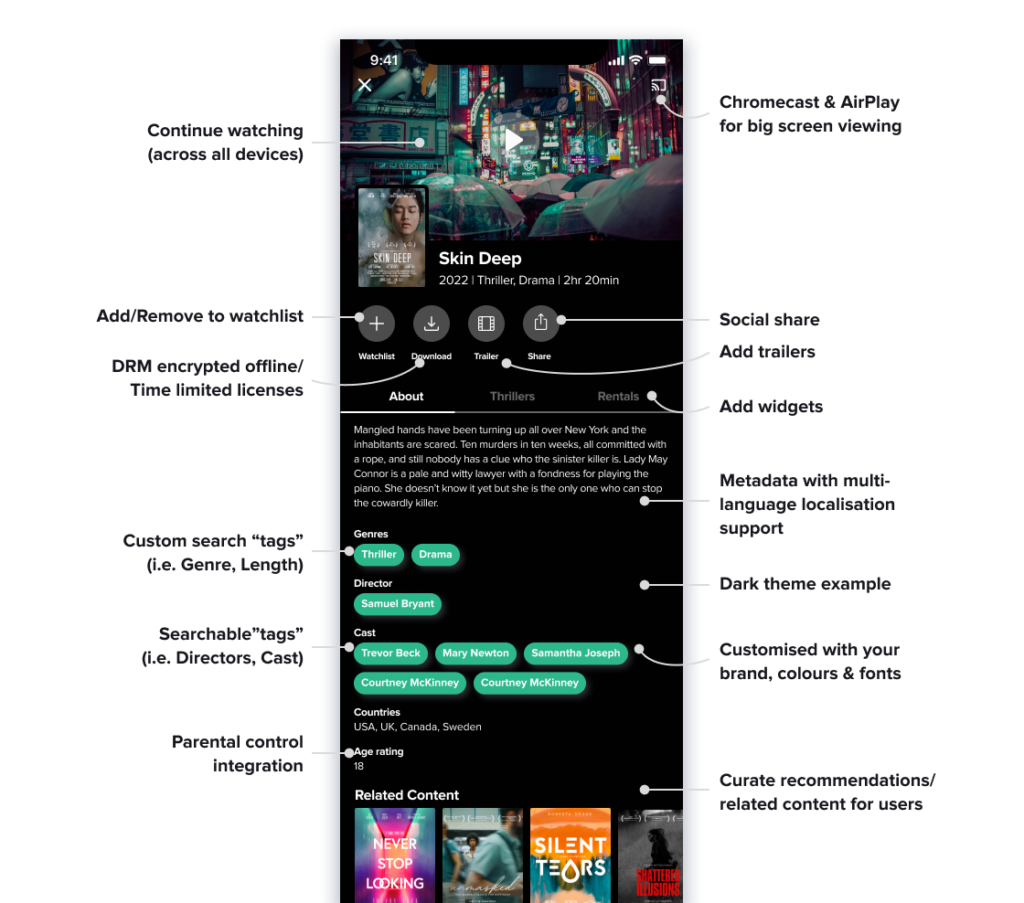Why OTT services are switching technology platforms: The key trends driving change

Making Headway in a Maturing Streaming Market
The streaming market is maturing. Hundreds of OTT services have launched in the past few years, from gigantic launches like Disney+ to smaller services that thrive by identifying a content niche and super-serving its fans. But many of these smaller niche services got their start in OTT on low-cost technology platforms like Vimeo or Viewlift. Now they’re finding the limitations of those platforms are acting as a brake on their growth.
Naturally, switching technology platforms comes with some discomfort. Most services will hold-off as long as they can. So what makes them finally take the plunge? From the many conversations we have with OTT services every month, here are some of the key reasons they’re looking to move to a more fully-featured OTT platform. Perhaps you can identify with some (or all) of these challenges?
Being Part of The Big Screen Battle
-
- The number one complaint we hear from OTT services is that their current technology platform doesn’t allow them to reach popular Smart TV brands like LG,Samsung and Vizio. At a time when viewership on these devices is exploding, content providers can’t afford to miss the boat. Research suggests Smart TVs now account for half of all adult streaming viewing.
-
- But even where platforms can provide a tick in the box for LG and Samsung, we hear from OTT services who are disappointed to discover app support only goes back a few years or lacks the feature depth coverage or quality. With the average Smart TV having an in-home shelf-life of closer to 7-10 years, it’s important to find a platform that offers apps for older models of device.
If you’re not sure whether it’s worth making the switch to a new OTT platform to get access to Big Screen apps, we highly recommend checking out the pros and cons in our whitepaper: Go Big or Stay Small?
Maximising Revenue With Hybrid Business Models
-
-
Smaller SVOD services are looking to capitalise on the blended monetisation approaches adopted by their bigger rivals. They’d like to provide a multi-package offering, with cheaper subscriptions for viewers who are willing to watch some level of advertising, and a premium package for those who want (and can afford) to go ad-free. Or to segment their packages for different video content catalogues to offer, for example, a sports subscription, or documentary subscription as unbundled offers alongside a “total” subscription that covers both.
- Many OTT services that launched with pure SVOD now find it difficult to pivot because their technology platform doesn’t offer AVOD or doesn’t have support for ad-insertion based on the SCTE-35 markers that are used in broadcast television.
-
-
-
As with big screen support, with AVOD the devil is in the detail. Platforms that promise AVOD support often struggle to offer billing adaptability. They force content providers to choose one business model per asset, rather than supporting a choice of ways to watch the same movie or TV show.
-
At the business end, platforms often struggle with handling revenue assurance and churn prevention (active & passive churn). Often platform providers will only deliver simple dunning mechanisms, if any, rather than look at toolsets to actively manage passive and active churn.
-
You’ll find lots of OTT case studies and advice on picking the right monetisation models in our Whitepaper, The Profit Playbook.
User Experience Challenges That Damage Engagement and Loyalty
As the streaming market matures, so do the tastes of viewers. We’ve all become used to the high-quality UX of the industry’s big players and expect the same wherever we watch.
We hear constantly from OTT services that are looking to switch to a new technology platform to gain support for premium features that improve UX and have a proven impact on engagement, features like:
- AI/ML-powered personalisation of content
- Automatic trailer previews & clear user calls to action
- Full multi-language localisation of apps, metadata, and content (including support for multi-track audio and multi-language subtitles)
These features are essential to ARPU growth and churn reduction. The image below shows even more UX elements you should look out for when shopping for a new OTT platform:
Perhaps you’re also coming to realise the limitations imposed by your platform in terms of app configurability? Do your apps look just the same as all the others? Do they really speak to your brand? To really stand out and grow in the market you need the ability to choose from more than a handful of fonts, menus and languages for localising your apps. Find out more about how to build apps that are truly tailored to your brand identity here.
Solving The Headaches of Niche Streaming Services
Do these challenges sound familiar? At Magine Pro, we’ve been where you are. Having operated a B2C streaming service before offering our OTT platform as a SaaS solution to other OTT services, we know that moving platforms is a daunting prospect. But the challenges outlined above show that it’s worth making the move to a new platform that offers big-screen apps, business model flexibility, and an attractive user experience.
The trick is to find a vendor that understands your challenges and offers all the features you need for now and the future, so you don’t need to contemplate another switch in two or four years’ time. Our team has significant experience in supporting other OTT services to migrate. You’ll find more information in this recent blog post, where our Head of Engineering and Operations, Marcus Lindén, outlines the key challenges involved and walks through some of the decisions you’ll need to make to smooth your migration journey.
Ready to Overcome Your OTT Platform Limitations?
To discuss with our experts how the Magine Pro OTT platform can help you overcome some of the limitations of your existing technology provider, book a meeting with our team.

